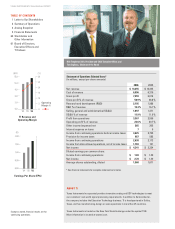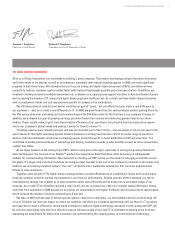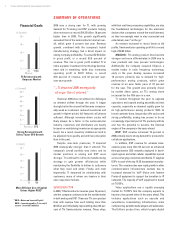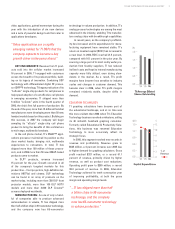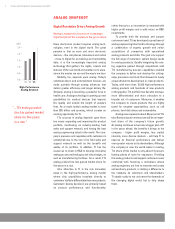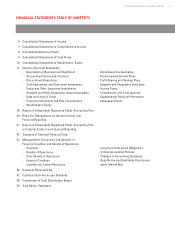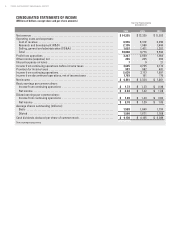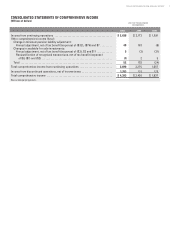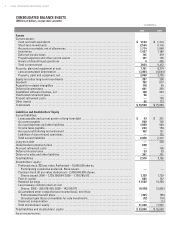Texas Instruments 2006 Annual Report Download - page 4
Download and view the complete annual report
Please find page 4 of the 2006 Texas Instruments annual report below. You can navigate through the pages in the report by either clicking on the pages listed below, or by using the keyword search tool below to find specific information within the annual report.
TEXAS INSTRUMENTS 2006 ANNUAL REPORT
2
SUMMARY OF OPERATIONS
2006 was a strong year for TI, with growing
demand for TI analog and DSP products helping
drive revenue to a record $14.25 billion, 16 percent
higher than in 2005. This growth significantly
exceeded that of the semiconductor market over-
all, which grew 9 percent last year. Revenue
growth, combined with the company’s hybrid
manufacturing strategy, had a direct impact on
raising company profitability. TI earned $7.26 billion
in gross profit, or a record 50.9 percent of
revenue. This rise in gross profit enabled TI to
make a greater investment in technology develop-
ment and in marketing, while also increasing
operating profit to $3.37 billion, a record
23.6 percent of revenue, and 32 percent year-
over-year growth.
However, 2006 was not without its challenges
as demand shifted through the year. It began
strongly but by the second half became unseason-
ably weak as customers reduced inventories and
growth in higher-priced, full-featured cell phones
softened. Although inventory-driven cycles will
likely always be a factor in the semiconductor
industry, customers and distributors are keenly
focused on maintaining inventories at appropriate
levels. As a result, inventory imbalances tend to
be adjusted more quickly and with less disruption
than in the past.
Despite near-term pressures, TI departed
2006 strategically stronger than it entered. The
company’s overall portfolio was richer, and its
market positions in analog and DSP were
stronger. TI continued to refine its manufacturing
strategy to gain greater efficiencies while
maintaining the flexibility to deliver to customers
what they need and when. Finally, and most
importantly, TI deepened its relationships with
customers, many of whom are leaders in their
own respective markets.
SEMICONDUCTOR
In 2006, TI Semiconductor revenue grew 16 percent,
and the company continues to be the market leader
in both analog and DSP. These are TI’s core product
lines with revenue from each totaling more than
$5 billion and individually representing about 40 per-
cent of TI’s Semiconductor revenue. These chips,
with their real-time processing capabilities, are also
the foundational technologies for the electronic
devices that consumers around the world demand,
as they increasingly want to stay connected and
entertained, even “on the go.”
As revenue increased to record levels so did
profits. Semiconductor operating profit hit a record
high of $3.83 billion.
ANALOG:TI’s analog product lines became
stronger and more differentiated in 2006 due to
new products and new process technologies.
Additionally, the company acquired Chipcon, a
market leader in radio frequency technology,
early in the year. Analog revenue increased
18 percent, primarily due to demand for high-
performance analog products, which grew
revenue at an even faster pace of 33 percent
for the year. This growth was primarily driven
by market share gains, as TI’s analog share
increased for the fifth year in a row.
TI worked throughout the year to upgrade
operations and expand analog assembly and test
capacity, especially as demand rapidly grew for
its high-performance analog products. With its
broad customer base, long product life cycles and
strong profitability, analog has proven to be an
increasingly important part of TI’s productportfolio
and has the potential to become the financial
engine of the company in the years ahead.
DSP:DSP revenue increased 16 percent in
2006 primarily due to strong demand for products for
cell phone applications.
In addition, DSP revenue for wireless base-
stations grew more than 60 percent as advanced
third-generation (3G) networks deployed in devel-
oped regions and initial cellular capabilities spread
across emerging economies worldwide. TI supplies
DSPs to each of the top 10 3G basestation manufac-
turers. The company also saw rapid growth in other
communications infrastructure markets due to
increased demand for VoIP (Voice over Internet
Protocol) equipment to support the transition to IP
networks. The majority of VoIP equipment is based
on TI DSPs.
Video applications are a rapidly emerging
market for TI DSPs that the company expects to
become a key growth driver in the years ahead. This
includes applications such as security and
surveillance, broadcasting infrastructure, video
conferencing, portable media players and automotive.
The DaVinci product line, which targets digital
Financial Goals
* ROIC = Return on Invested Capital
ROIC = (operating profit x (1-tax rate))/
(assets - non-debt liabilities)
“ ...TI departed 2006 strategically
stronger than it entered.”


